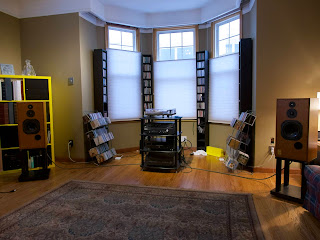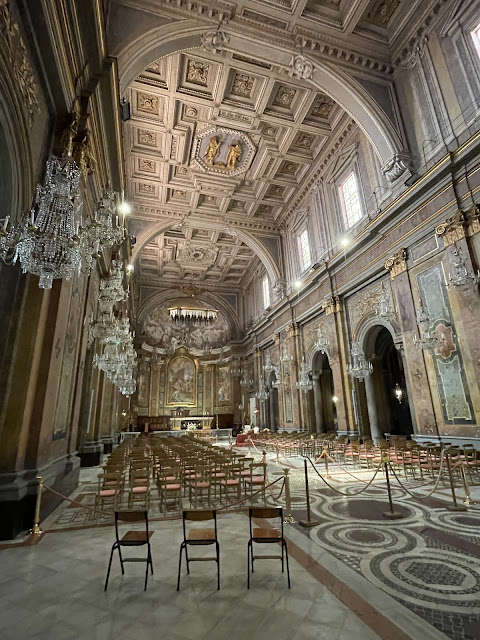"Gregorian" Chant
As promised, a little reflection on Gregorian chant is forthcoming at last. In history editors often get credit that one might otherwise attribute to inventors. What we call Gregorian chant was really the codification of a system of chant that then was exported or standardized in the Latin Church.
Church history is blessed with many pivotal and key moments that have emblazoned themselves on our common life for many successive generations.
Characters like St. Augustine of Hippo, St. Francis of Assisi, St. Thomas Aquinas, St. Ignatius of Loyola, Blessed John Henry Cardinal Newman, St. John Paul II, all have provided outsized influence on Catholicism. And of course, this is by no means an exhaustive list.
Musically, chant has most probably always been part of Christian worship and certainly reached its status as a critical contributor in the early monastic period.
Early chant indicative of the Roman Church (see Harmonia Mundi issued CD - Chant de L'Eglise de Rome, with Ensemble Organum, directed by Marcel Peres - the CD I have issued in 1998) did not have the characteristic rise and fall that we associate with Gregorian Chant. It was not monotone, but closer to being that, with strong unison singing.
 The fact that chant was most characteristic of monastic life says something also about the make up of the Church at the time. Not only were there what we would term professed religious, but communities and associations were diverse and meaningful. Gathered in prayer at cathedrals were canons who indeed were joined by promises and whose worship was directly linked to that of the bishop. In St. Gregory's time the development of monasteries that would really transform Europe was well underway. He famously, for example, sent St. Augustine to Canterbury, establishing both a monastery and Church governance more intimately connected to Rome.
The fact that chant was most characteristic of monastic life says something also about the make up of the Church at the time. Not only were there what we would term professed religious, but communities and associations were diverse and meaningful. Gathered in prayer at cathedrals were canons who indeed were joined by promises and whose worship was directly linked to that of the bishop. In St. Gregory's time the development of monasteries that would really transform Europe was well underway. He famously, for example, sent St. Augustine to Canterbury, establishing both a monastery and Church governance more intimately connected to Rome.
 It was natural, then, praying the Office (using what we would now call the Graduale Romanum), that greater emphasis and meditation on texts could be added by ornamentation. Though plainchant continued well into the high Middle Ages, roots were already there for a flowering of more elaborated chant. It is to be expected that, chanting the same office month after month and year into year, the creative mark should appear along the way.
It was natural, then, praying the Office (using what we would now call the Graduale Romanum), that greater emphasis and meditation on texts could be added by ornamentation. Though plainchant continued well into the high Middle Ages, roots were already there for a flowering of more elaborated chant. It is to be expected that, chanting the same office month after month and year into year, the creative mark should appear along the way.
So while Gregorian Chant became a norm in the Latin Church, I would not be very confident in asserting that it was exclusive.
While in recent decades the use of chant had dimmed, especially in the 1970's, there is not only renewed interest but a real capacity to integrate it with the variety of music sources and insights that guide its purpose. It is all about worship and the purpose that chant serves is to give greater emphasis to the words of the text. That is why who is doing the worshipping is important. Liturgy always has catechetical value, but it is centrally and you could say at the same entirely worship, to which each person worshipping needs the capacity to join appropriately.
 I love chant and I love polyphony too and there are contemporary liturgical pieces that are beautiful, appropriate and able to support wide participation. I am blessed at my parish to have one of our music groups steeped in the classical tradition who are able to bring the place of chant and some of the other treasures of the Church's worship from past centuries to present prayer.
I love chant and I love polyphony too and there are contemporary liturgical pieces that are beautiful, appropriate and able to support wide participation. I am blessed at my parish to have one of our music groups steeped in the classical tradition who are able to bring the place of chant and some of the other treasures of the Church's worship from past centuries to present prayer.
My next little rumination will be on Latin as a language relative to music and in its written and spoken forms.
Church history is blessed with many pivotal and key moments that have emblazoned themselves on our common life for many successive generations.
Characters like St. Augustine of Hippo, St. Francis of Assisi, St. Thomas Aquinas, St. Ignatius of Loyola, Blessed John Henry Cardinal Newman, St. John Paul II, all have provided outsized influence on Catholicism. And of course, this is by no means an exhaustive list.
Musically, chant has most probably always been part of Christian worship and certainly reached its status as a critical contributor in the early monastic period.
Early chant indicative of the Roman Church (see Harmonia Mundi issued CD - Chant de L'Eglise de Rome, with Ensemble Organum, directed by Marcel Peres - the CD I have issued in 1998) did not have the characteristic rise and fall that we associate with Gregorian Chant. It was not monotone, but closer to being that, with strong unison singing.
 The fact that chant was most characteristic of monastic life says something also about the make up of the Church at the time. Not only were there what we would term professed religious, but communities and associations were diverse and meaningful. Gathered in prayer at cathedrals were canons who indeed were joined by promises and whose worship was directly linked to that of the bishop. In St. Gregory's time the development of monasteries that would really transform Europe was well underway. He famously, for example, sent St. Augustine to Canterbury, establishing both a monastery and Church governance more intimately connected to Rome.
The fact that chant was most characteristic of monastic life says something also about the make up of the Church at the time. Not only were there what we would term professed religious, but communities and associations were diverse and meaningful. Gathered in prayer at cathedrals were canons who indeed were joined by promises and whose worship was directly linked to that of the bishop. In St. Gregory's time the development of monasteries that would really transform Europe was well underway. He famously, for example, sent St. Augustine to Canterbury, establishing both a monastery and Church governance more intimately connected to Rome.  It was natural, then, praying the Office (using what we would now call the Graduale Romanum), that greater emphasis and meditation on texts could be added by ornamentation. Though plainchant continued well into the high Middle Ages, roots were already there for a flowering of more elaborated chant. It is to be expected that, chanting the same office month after month and year into year, the creative mark should appear along the way.
It was natural, then, praying the Office (using what we would now call the Graduale Romanum), that greater emphasis and meditation on texts could be added by ornamentation. Though plainchant continued well into the high Middle Ages, roots were already there for a flowering of more elaborated chant. It is to be expected that, chanting the same office month after month and year into year, the creative mark should appear along the way. So while Gregorian Chant became a norm in the Latin Church, I would not be very confident in asserting that it was exclusive.
While in recent decades the use of chant had dimmed, especially in the 1970's, there is not only renewed interest but a real capacity to integrate it with the variety of music sources and insights that guide its purpose. It is all about worship and the purpose that chant serves is to give greater emphasis to the words of the text. That is why who is doing the worshipping is important. Liturgy always has catechetical value, but it is centrally and you could say at the same entirely worship, to which each person worshipping needs the capacity to join appropriately.
 I love chant and I love polyphony too and there are contemporary liturgical pieces that are beautiful, appropriate and able to support wide participation. I am blessed at my parish to have one of our music groups steeped in the classical tradition who are able to bring the place of chant and some of the other treasures of the Church's worship from past centuries to present prayer.
I love chant and I love polyphony too and there are contemporary liturgical pieces that are beautiful, appropriate and able to support wide participation. I am blessed at my parish to have one of our music groups steeped in the classical tradition who are able to bring the place of chant and some of the other treasures of the Church's worship from past centuries to present prayer. My next little rumination will be on Latin as a language relative to music and in its written and spoken forms.


